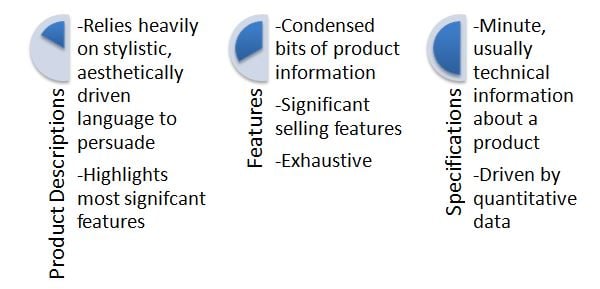Creating interesting and informative content is comprised of 3 distinct areas: product attributes, product features and product descriptions. The different layers that make up a product’s record work together to both inform and capture a consumer’s attention and are tailored to each client's data model. These 3 areas cover distinct bandwidths of information. There’s an important balance between revealing the key product attributes and adhering to the important part in each section; this is a threefold system that communicates different sorts of information. Our system involves starting with a product’s intricate details, moving to its innovative and significant features, then ending with a more aesthetically centered write-up that consumers can easily read while finding key information.
When one of our content writers tackles a product content record, it’s imperative to first look at the product down to its most intricate details, provided by our acquisition team. Here, writers list the minute product attributes which can include details like warranty information, measurements and specific functions. In addition to answering important questions, such as "Will this fit in my living room?", "Will it work with my existing A/V equipment?" or "Can my daughter wear these to indoor soccer practice?", this data also enables clients to develop a collection taxonomy to organize products. If you've ever searched for a product, then used clarifying links on the left-hand side of a website, you've benefited from this type of product data management. Product attributes allow the creation of facets that help customers narrow their search from audio products to headphones to Bluetooth headphones to purple Bluetooth headphones, so e-commerce shoppers can quickly view the products that are most relevant to their needs.
From there, the product content expands into something easier to digest: products’ key features laid out for an informative, at-a-glance look. These serve as a condensed, yet comprehensive list of the product at hand and provide context and explanation for technologies or features which the customer may not be familiar with. Likely, these tidbits of information will not all transfer over to the longer write-up of a product. These types of product attributes can include a product’s construction, function or innovative features. This section of the record contains key components from the specifications and record. It relies on persuasive language while still providing specific information in a way that the descriptive, language-based section does not.
Moving on from a product’s list of components, we augment the most significant and innovative features with persuasive language that encourages a consumer to buy the product at hand. This is where a consumer is able to see the significance of the product in their life and learn about what makes the item unique and worth buying. This is also the most stylistically heavy component of the record because it relies so much on clear, concise language to persuade and inform. First impressions are important, and this is where a consumer begins: we must present the most important information here to encourage a potential buyer to keep reading.
Creating comprehensive, yet concise product content is at the heart of what we do. In doing so, we help our clients inform consumers about products that are pertinent to their lives and enable them to make a smart purchase. How does your company create a marketing system? Leave your comments below.
Data integrity, time to market and increased conversions are vital to all e-commerce retailers. Our product data management and unique content creation program ensures consistent product names, robust product descriptions, complete and accurate product attributes and an array of digital assets are at your disposal, providing time to market and quality improvements that will outpace your fiercest competition. Contact our team and get started with Virtucom Group today.






